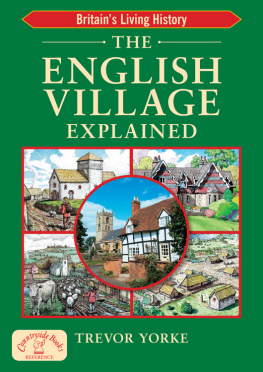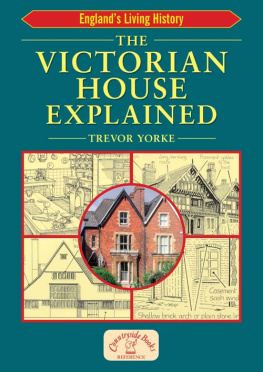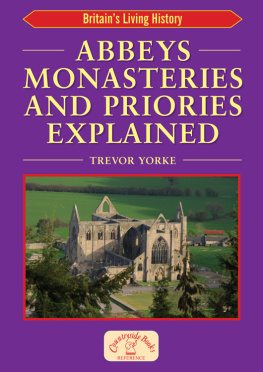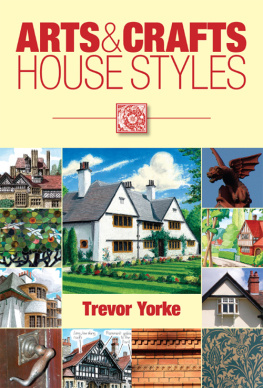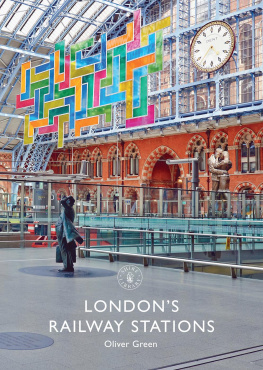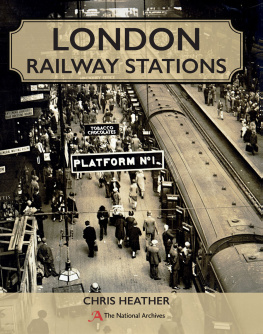Trevor Yorke - Victorian Railway Stations
Here you can read online Trevor Yorke - Victorian Railway Stations full text of the book (entire story) in english for free. Download pdf and epub, get meaning, cover and reviews about this ebook. publisher: Countryside Books, genre: Non-fiction. Description of the work, (preface) as well as reviews are available. Best literature library LitArk.com created for fans of good reading and offers a wide selection of genres:
Romance novel
Science fiction
Adventure
Detective
Science
History
Home and family
Prose
Art
Politics
Computer
Non-fiction
Religion
Business
Children
Humor
Choose a favorite category and find really read worthwhile books. Enjoy immersion in the world of imagination, feel the emotions of the characters or learn something new for yourself, make an fascinating discovery.
- Book:Victorian Railway Stations
- Author:
- Publisher:Countryside Books
- Genre:
- Rating:4 / 5
- Favourites:Add to favourites
- Your mark:
- 80
- 1
- 2
- 3
- 4
- 5
Victorian Railway Stations: summary, description and annotation
We offer to read an annotation, description, summary or preface (depends on what the author of the book "Victorian Railway Stations" wrote himself). If you haven't found the necessary information about the book — write in the comments, we will try to find it.
Victorian Railway Stations — read online for free the complete book (whole text) full work
Below is the text of the book, divided by pages. System saving the place of the last page read, allows you to conveniently read the book "Victorian Railway Stations" online for free, without having to search again every time where you left off. Put a bookmark, and you can go to the page where you finished reading at any time.
Font size:
Interval:
Bookmark:


COUNTRYSIDE BOOKS
3 Catherine Road
Newbury
Berkshire
RG14 7NA
To view our complete range of books, please visit us at
www.countrysidebooks.co.uk
First published 2015
Text 2015 Trevor Yorke
Photos and illustrations 2015 Trevor Yorke
Photos of Micheldever, Windsor and Eton Riverside,
and Birmingham Moor Street Stan Yorke
Cover photograph shows Ribblehead Station, North Yorkshire,
restored by The Settle and Carlisle Railway Trust.
Page 1 photograph shows Hellifield Station, Skipton, North Yorkshire
The right of Trevor Yorke to be identified as the author of this work
has been asserted by him in accordance with the Copyright,
Designs, and Patents Act 1988.
All rights reserved. No part of this publication may be reproduced, stored in a
retrieval system, or transmitted by any means, electronic, mechanical,
photocopying, recording or otherwise, without the prior written permission
of the copyright holder and publishers.
A CIP record for this book is available from the British Library.
ISBN 978 1 84674 335 1
Produced by The Letterworks Ltd., Reading
Typeset by KT Designs, St Helens
Printed by Berforts Information Press, Oxford

The Great Hall in Euston Station was opened in 1849. The impressive stairs led to offices above. The marble statue is of the prominent railway engineer, George Stephenson. He chose this site as the terminus for the London and Birmingham Railway. The Great Hall was controversially demolished in 1962. The statue now stands in the National Railway Museum, in York.
T he Victorian railway station is more than a grand pile of bricks or stone. Its structure represents the architectural fashions of the age and the latest in Victorian building technology. The historic styles used were intended to reassure and complement their surroundings; harmonising with neighbouring buildings which may have long since gone.
A Victorian railway stations grand size and lavish decoration displays the ambitions and pride of the railway companies who erected them, as well as the complex business of running a 19th-century railway. The numerous doorways, which once led to a wide array of waiting rooms and offices, record Victorian social divisions.
The station buildings we see today also bear an emotional element. The station was more than just an arrival and departure point; it was the centre of the community where parcels, letters and telegrams were sent and news received. Passing through their booking halls have been generations of important dignitaries, excited children departing for a holiday, and returning war-torn soldiers. Just imagine the thousands of emotional embraces and tearful farewells which have taken place under their platform canopies.
The buildings which have survived to the present day can appear to be a bewildering array of architectural details and complex room arrangements. This book intends to unravel these and explain when and why the stations were built. I have used my own drawings and photos to illustrate the different styles and types of station building which still stand today. I have also highlighted some of the interesting features to look out for, which reflect the Victorians attention to detail and their social habits.
The chapters are in chronological order and outline the developing story of the railways, the styles which were fashionable and examples of station buildings from the period. With over 10,000 stations of all shapes and sizes built over the last two hundred years of rail travel, I have had to restrict the book to those which I regard as architecturally interesting and are mostly open to the public today. I have included a list of preserved heritage railways and Victorian stations to visit, as well as a glossary to explain the more unfamiliar terms.
This book is intended as an introduction to a celebrated form of building which we have all at sometime passed through. Whether you are a rail enthusiast, model builder or a curious commuter, this book will open up a new appreciation of this vital element of our glorious, Victorian heritage.
Trevor Yorke
Visit www.trevoryorke.co.uk for more information or follow me on Facebook at trevoryorke-author

Tudor style (top) and Classical style (bottom) Victorian railway stations.
VICTORIAN RAILWAY STATIONS |

St Pancras Station, London:George Gilbert Scotts Midland Hotel is a Gothic masterpiece which reflects the ambitions and confidence of Victorian railway companies. It opened in 1873 and still offers luxury accommodation.
V ictorian stations stand today as a tangible monument to the railway age. Their impressive structures and colourful historic styles reflect not just the admirable quality of buildings from this period, but also the ambition and confidence of the men who designed and built this exciting new transport system. Just as the railways were at the cutting edge of 19th century technology, so the station buildings were built in the latest styles with their glorious faades designed by the eras leading architects.
Railway stations were one of the few places where society would intermingle. Although early stations were geared towards the well off, it was not long before the middle and working classes were crowding upon the same platforms. In most communities the railway station was the primary link to the outside world, the point where distant friends and family were received, the latest news and fashions discovered and local produce dispatched to far off cities. Victorian industry and society revolved around the railway station; towns and cities were drawn towards their location with new housing, warehousing and factories developing around them. The buildings which stand today reflect this importance, and the demands, desires and expectations of the railway companies and their passengers.

Darlington, County Durham:Station built in fields on the edge of what was a small market town. In 1887, when the building was rebuilt with its impressive tower, the town had begun to spread around the site and today it seems part of the urban area.
In the early days of the railways, one reason why the railway companies felt the need to build such magnificent buildings was to reassure a nervous public. These thundering iron machines spitting sparks and billowing smoke, hurtled along at speeds faster than anyone had ever travelled before. They invoked wonder and fear. Many people believed the trains were monstrous, dangerous creations that would blacken the landscape and terrify livestock. By building such permanent and impressive stations in major cities and towns, the railwaymen sought to dispel these fears.
Font size:
Interval:
Bookmark:
Similar books «Victorian Railway Stations»
Look at similar books to Victorian Railway Stations. We have selected literature similar in name and meaning in the hope of providing readers with more options to find new, interesting, not yet read works.
Discussion, reviews of the book Victorian Railway Stations and just readers' own opinions. Leave your comments, write what you think about the work, its meaning or the main characters. Specify what exactly you liked and what you didn't like, and why you think so.


